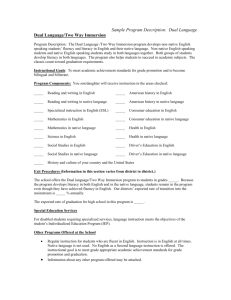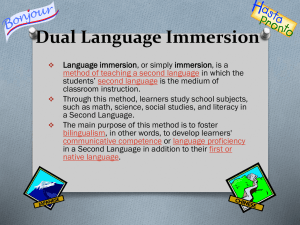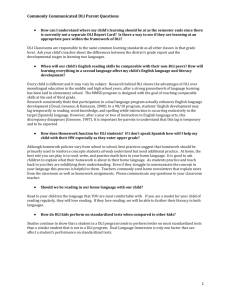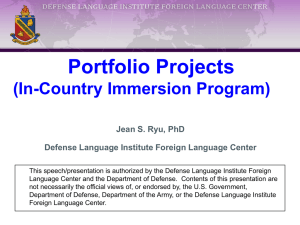Dual Language/Immersion (DLI) & Title I Funds
advertisement
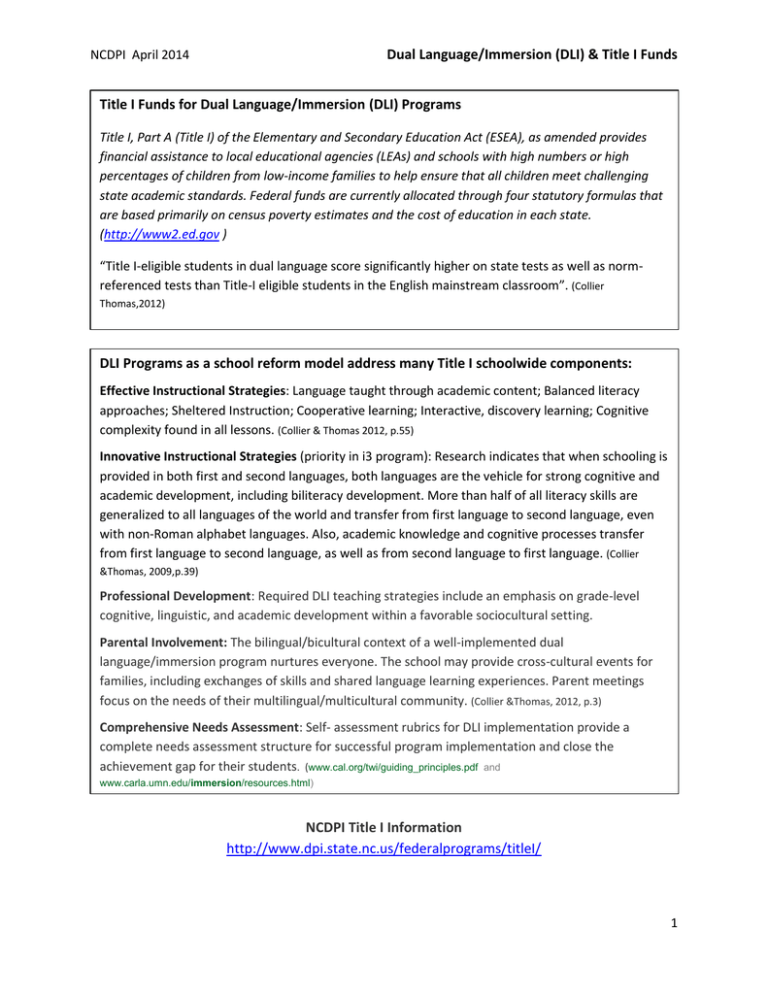
Dual Language/Immersion (DLI) & Title I Funds NCDPI April 2014 Title I Funds for Dual Language/Immersion (DLI) Programs Title I, Part A (Title I) of the Elementary and Secondary Education Act (ESEA), as amended provides financial assistance to local educational agencies (LEAs) and schools with high numbers or high percentages of children from low-income families to help ensure that all children meet challenging state academic standards. Federal funds are currently allocated through four statutory formulas that are based primarily on census poverty estimates and the cost of education in each state. (http://www2.ed.gov ) “Title I-eligible students in dual language score significantly higher on state tests as well as normreferenced tests than Title-I eligible students in the English mainstream classroom”. (Collier Thomas,2012) DLI Programs as a school reform model address many Title I schoolwide components: Effective Instructional Strategies: Language taught through academic content; Balanced literacy approaches; Sheltered Instruction; Cooperative learning; Interactive, discovery learning; Cognitive complexity found in all lessons. (Collier & Thomas 2012, p.55) Innovative Instructional Strategies (priority in i3 program): Research indicates that when schooling is provided in both first and second languages, both languages are the vehicle for strong cognitive and academic development, including biliteracy development. More than half of all literacy skills are generalized to all languages of the world and transfer from first language to second language, even with non-Roman alphabet languages. Also, academic knowledge and cognitive processes transfer from first language to second language, as well as from second language to first language. (Collier &Thomas, 2009,p.39) Professional Development: Required DLI teaching strategies include an emphasis on grade-level cognitive, linguistic, and academic development within a favorable sociocultural setting. Parental Involvement: The bilingual/bicultural context of a well-implemented dual language/immersion program nurtures everyone. The school may provide cross-cultural events for families, including exchanges of skills and shared language learning experiences. Parent meetings focus on the needs of their multilingual/multicultural community. (Collier &Thomas, 2012, p.3) Comprehensive Needs Assessment: Self- assessment rubrics for DLI implementation provide a complete needs assessment structure for successful program implementation and close the achievement gap for their students. (www.cal.org/twi/guiding_principles.pdf and www.carla.umn.edu/immersion/resources.html) NCDPI Title I Information http://www.dpi.state.nc.us/federalprograms/titleI/ 1 NCDPI April 2014 Dual Language/Immersion (DLI) & Title I Funds Dual Language/Immersion (DLI) Program Model as School Reform Models The DLI program model is a federal and nationally recognized model as an effective and significant instructional model for closing the achievement gap for all learners. Research consistently demonstrates the advantage of a dual language education program that is sustained and consistent (e.g., August & Hakuta, 1997; Cazabon, Lambert, & Hall, 1993; Christian & Genesee, 2001; Christian et al., 1997; de Jong, 2002; Howard, Christian, & Genesee, 2003; Howard, Sugarman, & Christian, 2003; Kirk Senesac, 2002; Lambert & Cazabon, 1994; Lindholm-Leary, 2001; Lindholm-Leary & Borsato, 2001, 2006; Ramirez, 1992; Ramirez, Yuen, & Ramey, 1991; Thomas & Collier, 2002, 2012; Willig, 1985). In addition, most long-term studies reported that the longer the students stayed in the dual language programs, the more positive the outcomes. These results were true whether the outcomes included reading achievement, mathematics achievement, grade point average, attendance, school completion, or attitudes toward school and self. The North Carolina longitudinal research conducted by Thomas and Collier (2009,2010) also indicates that a high percentage of students in North Carolina two-way models are attaining proficiency on the NC state Reading and Mathematics End-of Grade Tests beginning in the 3rd grade and continuing this level of high achievement throughout Grades 3-8. The impact of schooling through two languages is very positive and is evidenced in EOG test scores for all populations of students, including Caucasian, Hispanic, African-American, students with special needs or exceptionalities, as well as students of low-income background as measured by free and reduced lunch. School districts implementing one-way immersion models with mostly native English speakers are reporting similar results. “We challenge our schools and communities to invest in our future leaders with biliteracy and multiliteracy skills.” Arne Duncan, U.S. Secretary of Education and Libia S. Gil, Assistant Deputy Secretary of the Office of English Language Acquisition in the Department of Education. (2/19/2014) NCDPI Dual Language/Immersion Information Program Information: http://wlnces.ncdpi.wikispaces.net/Dual+Language+&+Immersion+Program Thomas and Collier Research: http://gled.ncdpi.wikispaces.net/DLI+Research Available in Spring 2015: NCDPI Dual Language/Immersion Wiki 2
